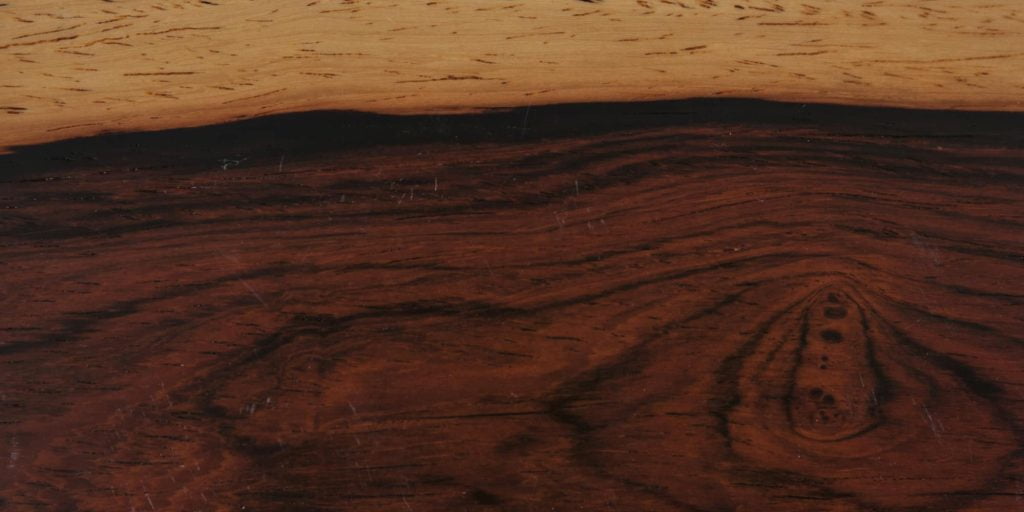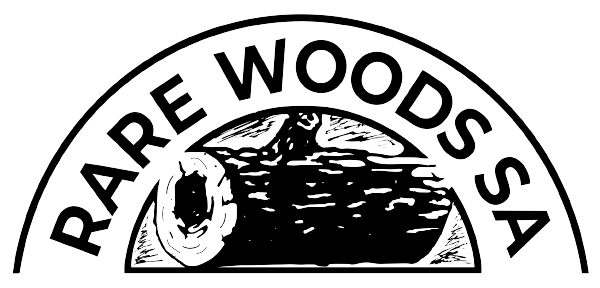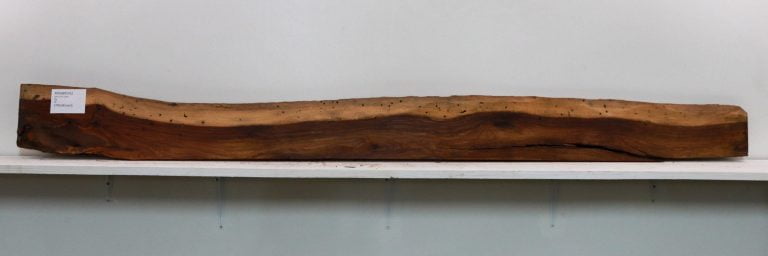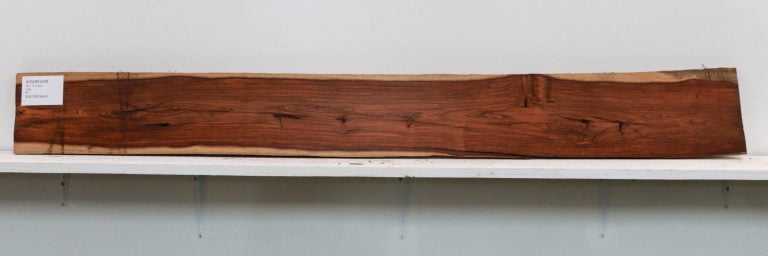Rosewood – Brazilian
Quick Look

With its outstanding strength-to-weight ratio, density, stability and resonance, it is easy to see why Brazilian Rosewood became the wood synonymous with “rosewood” in the world of both acoustic and electric guitar building, in the last century. It is also renowned for its use in fine furniture, cabinetry, as veneer and paneling, and more. Its wide popularity and huge demand led to its eventual placement on CITES Appendix I, back in early 1992. Not only is it illegal to import or export the wood from one country to another, but it is also illegal export finished products containing the legendary Dalbergia.
The wood is typically a dark chocolate brown, although it can possess varying degrees of reddish or purplish tint, as well as having a variety of secondary colors sometimes woven in to its grains. Grain patterns can run the gamut — from straight, to interlocked, wavy or irregular — with a medium texture that can be quite porous. Brazilian Rosewood is generally considered a cooperative working wood, although its density requires sharp tools and blades. It finishes well and has a nice natural luster, although — with its high natural oil content — it can be difficult to glue.
This species is listed in the CITES Appendix I, and classified as “Endangered” on the IUCN Red List of Threatened Species; part of the Dalbergia -genus worldwide exportation ban.
Why We Love This Wood
Brazilian Rosewood was entrenched in guitar luthiery (both acoustic & electric) through the '90's, after which time its supply in the US had declined to the point of sending craftsmen in search of alternatives. It truly is the "holy grail" of guitar tonewoods; with its evenly balanced, rich tonal spectrum, it is the standard by which all others are judged.Since its exportation ban went into effect, supplies have been limited to the existing stockpiles already present in the US. Because of its abundant use, that supply, at the time, was quite subtantial. Now, it has dwindled down to the point of being almost impossible to obtain and being extremely pricey.Aside from being one of the exotic wood industry's most covered species, it is also one of the most impersonated: with dishonest sellers infrequently popping up, offering other rosewoods with similar aesthetic qualities and calling Brazilian Rosewood.
Quick Look

Vital Statistics
| Main Color Group | Variegated |
| Grain Pattern | Figured |
| Avg Dry Weight - LB/FT3 | |
| Avg Dry Weight - KG/M3 | |
| Janka Hardness - LBF | 2790 |
| Janka Hardness - N | 12410 |
A Popular Choice in
Search With Filters
R7,257.44
R4,061.90
R6,659.63
R6,144.54
R4,068.57
R8,230.44
R2,573.82
R2,753.97
R5,276.23
R9,388.54
Other Species
Durable and relatively affordable, European Chestnut is a popular cladding species in Europe. With looks similar to Oak and Ash, we are sure you will love the appearance of Sweet Chestnut. Grain can be interlocked, but Chestnut is still relatively easy to work. It can split relatively easily, so pre-drilling is essential.
This is a new species for us here at Rare Woods and a first for South Africa. We are delighted with what arrived and can’t wait to get it into some of your projects.
Detail
Common Uses
Longhi is an African wood with similar working properties to its more well-known cousin, Anegre. Its color varies from a greyish-white to beige to pinkish-brown color, which slightly darkens with age and UV-ray exposure. Its generally light appearance makes sapwood difficult to distinguish. Its grains are typical straight (though occasionally interlocked) and its texture ranges between fine and medium-fine. It can sometimes possess mottled or subtle tiger-striped figuring.
The wood must be carefully dried, as it is susceptible to fungus. It is considered to be moderately durable, and moderately stable. Longhi has a solid strength-to-weight ratio, which makes it a popular choice for flooring and decking.
cabinetry, decking, flooring, furniture
Detail
Common Uses
“Roasting” Flame Birch involves gradually heating the wood up to temperatures of greater than 160 degrees celcius in special heat chambers made of stainless steel under anoxic conditions. The heat removes organic compounds from the wood cells, changing both the physical and chemical make-up of the wood. The process is natural and chemical free. It darkens the wood to a beautiful rich chocolatey brown color whilst still showing the gorgeous grain and figure of the underlying wood.
The thermally modified wood is more dimensionally stable, but the process does reduce bending strength and make the wood a little more brittle. This makes it chip a little easier than the un-modified lumber. The brittleness makes it less suitable for intricate cabinetry, but it is still an excellent choice for less intricate items such as floors, tops, panels, cladding etc.
Extra care needs to be taken when finishing thermally modified wood, as the “bone dry” wood has a tendency to “suck in” much of what is given to it. Our in-house woodworking specialist has had excellent results with Osmo PolyX. He suggests a thicker finish will work better.
flooring, interior panelling
Detail
Common Uses
This Malaysian species is a medium weight timber suitable for light structural purposes. It is a popular joinery timber and it machines easily and finishes well.
furniture, joinery
Detail
Common Uses
Indigenous to the tropical regions of East Africa and West Africa, as far south as Angola.¬† Anegre has been used primarily as an interior wood; it is decidedly non-durable, and thus not recommended for outdoor applications. The wood’s aesthetics can vary greatly, as Anegre is comprised of three separate species within the Pouteria genus. Its colors can range from pale yellowish to orangish-brown wood, to a pale pinkish-brown, sometimes with additional highlight coloration. Anegre typically darkens to a golden-to reddish brown over time, with repeated UV ray exposure. The heartwood and sapwood of Anegre are usually not distinguishable from each other.
Anegre has a medium texture with closed pores similar to Maple.  The species is easy to work with both hand and power tools.
Examples can be quite beautiful — and sometimes stunning, with curly and mottled figuring being not uncommon. Its hues tend to be generally pastel in nature, so it makes a very complimentary, aesthetically unimposing wood for a variety of interior applications. Grains are typically straight but can occasionally be interlocked. Its texture is medium and it has a nice natural luster.
boatbuilding, cabinetry, carpentry, construction, veneer
Detail
Common Uses
Masur Birch (also known as Karelian Birch) is not a species in of itself, but rather a particular grain figure that occurs in various species of European Birch. The result is a beautiful marble like figure – a mix between burl and birdseye.
The cause of this figure is uncertain. Some say that it comes from a tree’s reaction to invasion by the larvae of the Agromyzia carbonara beetle, but the general opinion seems to be that it is hereditary, classifying the name of the variant as Betula pendula var. Carelica. Regardless of the exact origin of the figure, it provides us with stunning and unique looking lumber, just begging to be showcased in some fine woodworking. It is most commonly used in accent details, turned objects, knife handles and other small specialty items.
Veneers of Masur Birch are rotary cut (like Birdseye Maple) to ensure the best figure is extracted for the veneer.
fine furniture, knife handles, specialty items, turnings, veneer












